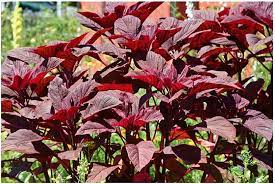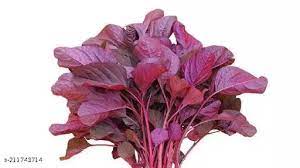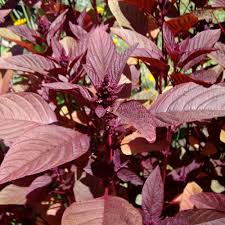Red amaranth Lal Saag- A Nutrient- Rich Superfood -2023
Red amaranth Lal Saag
Red amaranth Laal Saag is a colorful leafy vegetable that is a member of the amaranth family. It is scientifically known as Amaranthus tricolor. This plant, which is well-known for its vivid red and purple colors, is not only eye-catching but also very nourishing.

In many parts of the world, it is extensively grown and consumed for its medicinal properties.
Cultivation and Environment for Red amaranth Lal Saag:
Because red amaranth is a hardy plant that can withstand a variety of climates, it may be grown in a variety of environments. Most of Asia, Africa, and the Americas’ tropical and subtropical regions are where it is grown. The plant grows best in well-drained soil, and it can be found in fields, gardens, and in some places, even in the wild.
Red amaranth grows best in warm climates, though this can vary depending on the period of culture. It is a crop that can be grown all year round in many places, but it grows best in the warmer months.
Nutritional contents of Red amaranth Lal Saag:
The high nutritious value of red amaranth is a well-known attribute. Antioxidants, vitamins, and minerals are all present in good amounts in it. Vitamin A, C, calcium, iron, and folate content in the leaves is especially high. The antioxidant qualities of red amaranth are further enhanced by the presence of healthy substances like carotenoids and flavonoids.
A great method to increase your overall nutrient intake is by including red amaranth in your diet.
What is the best time to consume Red amaranth Lal Saag?
The optimal period for consuming red amaranth is when it’s in season and fresh. But it may be enjoyed on a regular basis because it is available year-round in many areas. Its nutritional benefits can be consistently consumed if you incorporate it into your regular meals, whether they are salads, sautés, or smoothies. Red amaranth can be overcooked, which can result in nutrient loss. Light cooking helps preserve the nutrient content of the plant.

Applications of Red amaranth Lal Saag in Cooking:
Red amaranth is a flexible ingredient that works well in a variety of recipes. With their subtle earthy flavor, the soft leaves are a great addition to soups, salads, stir-fries, and side dishes. Red amaranth is frequently used in pickles and other traditional recipes in several cultures. The vivid hue of the leaves enhances the visual attractiveness of culinary creations, rendering it a desirable option for both amateur and professional chefs.
Benefits of Red amaranth Lal Saag to Health:
Antioxidant-Rich: Red amaranth is rich in antioxidants, which lower the risk of chronic diseases and enhance general well-being by assisting the body in fighting oxidative stress.
Increased Vitamin A level: Enhanced eyesight and prevention of disorders such as night blindness are possible thanks to the high level of vitamin A.
The mineral calcium is necessary for strong and healthy bones, and red amaranth is a rich source of it.
Iron in Red Amaranth: Red amaranth’s high iron concentration helps to prevent and treat iron-deficiency anuria.
Immune system booster: Red amaranth’s vitamin and mineral content helps the body fight off infections and diseases by fostering a strong immune system.

Follow Our Digiknowledge.co.in Page for Latest update about Bikes, Cars, Sports, , Life style and many more.
Pregnancy and Folate: Red amaranth contains folate, which is essential for foetal development and the prevention of neural tube abnormalities.
Weight management: Red amaranth is a fantastic supplement to a diet that is focused on cutting calories and increasing fibre. The fibre helps with digestion and encourages satiety.
How to make Red amaranth Lal Saag at Home ?
Use the comprehensive recipe, step-by-step instructions, and video provided below to prepare this wholesome dish:
Ten minutes for the red spinach to soak in water and an additional five minutes for component preparation
Cooking Duration: Ten minutes
Four servings from this recipe
Components needed to make Laal Saag:
500 grammes of red spinach, often known as Lal sag or Chaulai ka saag.
Chop 4–5 garlic petals finely;
add 1 pinch of Asafoetida ; add 1/2 tea spoon of fenugreek seeds.
Salt according to preference
One table spoon of mustard oil and half a tea spoon of Red Chilli flakes
Guidelines
Apply medium heat to a pan of oil. Splutter the mustard seeds after adding them.
Combine minced garlic and finely chopped green chilies. Garlic should be sautéed until it turns yellow.
Toss in the chopped red amaranth leaves after they have been cleaned. Thoroughly mix the oil and spices into the leaves.
Add cumin, red chilli, turmeric, and salt for seasoning. Combine well.
Cook, tossing regularly, until the red amaranth leaves wilt and become soft, uncovered. That normally takes five to seven minutes.
Check the seasoning after cooking and make any necessary adjustments. To add a dash of citrus flavour to the dish, feel free to squeeze some fresh lemon juice on it.
Take the laal saag stir-fry off the stove and serve it as an accompaniment to roti or rice.
Note:- It is advisable to contact experts before enduring power of traditional remedies or using Red amaranth Lal Saag.
What are some of the benefits of Red amaranth Lal Saag?
Enhances digestive system, Facilitates weight loss, Addresses Anemia , Increases Renal function, Cures Asthma, Stabilises blood sugar levels.
What is the nutrition value of Red amaranth Lal Saag?
100grammes provide 23 calories.
0.3 grammes of fat
A protein gramme of 2.5
Four grammes of starches
Vitamin A
Vitamin C
Iron
Calcium
Calcium





Your article helped me a lot, is there any more related content? Thanks!
I’m glad to hear that the article was helpful for you! If you’re looking for more content on a similar topic or related topics, there are a few things you can do:
1. Check the blog archives: Browse through the archives of the blog to see if there are any other articles related to the topic you’re interested in. You might find additional articles that provide further insights or different perspectives.
2. Use search functionality: If the blog has a search feature, you can use it to search for specific keywords or topics related to the one you’re interested in. This can help you find relevant articles more quickly.
3. Explore related topics: Look for related topics or categories on the blog that might cover similar subject matter. Sometimes, there are broader themes or categories that encompass multiple related articles.
4. Subscribe for updates: If the blog offers a subscription option, consider subscribing to receive updates whenever new content is published. This way, you’ll stay informed about any future articles that might be relevant to your interests.
If you have a specific topic in mind or if there’s something specific you’re looking for, feel free to let me know, and I can try to provide more tailored recommendations or assistance.